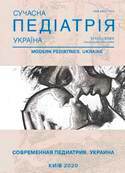Regurgitation syndrome in young children: diagnosis and correction
Keywords:
digestive system, regurgitation, children, anti-reflux mixturesAbstract
Today, functional disorders of the digestive system remain an actual problem of practical pediatrics and a common reason for parents to see doctors. Population survey suggest that during the first year of life, about half of the children have at least one of the symptoms of functional disorders of the gastrointestinal tract, and often a combination of several symptoms.Goal of research: to evaluate the clinical efficiency of antireflux blends in children with the syndrome of regurgitation.
Materials and methods. The 42 children aged 1 to 12 months were examined. Also during the children's clinical research was assessed a physical and mental development, neurological status. To exclude organic lesions of the digestive system, called pyloric stenosis, was used a modern ultrasound examination of the stomach. The main group consisted of 20 children who received anti-reflux milk formula, which has a polysaccharide — gum as a thickener. The comparison group consisted of 22 children who received a polysaccharide — starch as a thickener.
Results. In children who received anti-reflux therapeutic mixtures, with the content of two types of thickeners: gums and modified starch were identified changes in the intensity and frequency of regurgitation. Research experience has shown that the antireflux effect of the mixture, which contains gum as a thickener, occurs faster and has the most pronounced effect.
Conclusions. Correction of regurgitation syndrome in children should be complex and divided into several successive stages: explanatory work with the purpose of psychological support of parents, the use of progressive therapy when feeding the child, the normalization of the feeding schedule and the implementation of adequate diet therapy.
The research was carried out in accordance with the principles of the Helsinki Declaration. The study protocol was approved by the Local Ethics Committee (LEC) of a participating institution. The informed consent of the patient was obtained for conducting the studies.No conflict of interest was declared by the authors.
References
Belousova OYu. (2010). Dietoterapiya pri sindrome srygivaniya u detej rannego vozrasta. Zdorov'ya Ukrayiny. 4: 36–37.
Belousova OYu. (2015). Sovremennyj vzglyad na funkcionalnye zapory u detej rannego vozrasta: osobennosti vskarmlivaniya i principe nemedikamentoznoj terapii. Zdorov`e rebenka. 1(60): 150–158.
Efanova AA, Myshyna NV. (2017). Funkcionalnye narusheniya zheludochno-kishechnogo trakta i ih dietologicheskaya korrekciya u detej pervogo goda zhizni. Zdorov`e rebenka. 12; 2: 67–69.
Yesypova SI, Dmytryshyn BYa, Bovkun OA, Dmytryshyn OA. (2018). Pediatrichni kriteriyi Rimu IV: zmini ta porivnyannya z Rimskimi kriteriyami III. Semejnaya medycyna. 1(75): 20–23.
Zaxarova YN, Sugyan NG, Pikov MY. (2014). Sindrom srygivaniya u detej rannego vozrasta: diagnostika i korrekciya. Еffektyvnaya farmakoterapy`ya. 3: 18–28.
Ylchenko SY, Duka ED. (2016). Mikroaspiracionnyj sindrom v praktike pediatra: sovremennye osobennosti i rol v formirovanii bronhoobstruktivnogo sindroma. Zdorov`e rebenka. 7(75): 90–93.
Korenyuk OS. (2014). Efektivnist likuvalnogo harchuvannya v kompleksnij terapiyi sindromu zriguvannya u ditej grudnogo viku. Medychnyy forum. 2: 93–99.
Majdannyk VG, Ivannyk LM. (2013). Klinichni rekomendaciyi z diagnostiki ta likuvannya funkcionalnih gastroinstinalnih rozladiv u ditej. Kyiv: 66.
Majdannyk VG. (2016). Rimski kriteriyi IV: sho novogo?. Mizhnarodnyj zhurnal pediatriyi, akusherstva ta ginekologiyi. 10;1: 8–18.
Nyankovskyj SL, Ivaxnenko OS. (2010). Diyetoterapiya funkcionalnih porushen shlunkovo-kishkovogo traktu v ditej pershogo roku zhittya. Novosty medycyny y farmacyy v Ukrayne. 5: 15.
Nyankovskyj SL, Ivaxnenko OS, Yaczula MS. (2013). Principi harchovoyi korekciyi funkcionalnih rozladiv travnoyi sistemi u ditej rannogo viku. Zdorov`e rebenka. 4(47): 69–74.
Shadrin OG, Marushko TL, Polkovnychenko LM. (2012). Suchasni pidhodi do likuvannya sindromu regurgitaciyi u ditej rannogo viku. Zdorov`e rebenka. 6(41): 9–14.
Vandenplas Y, Ashkenazi A, Belli D. (1993). A proposition for the diagnosis and treatment of gastro-oesophageal reflux disease in children: a report from a working group on gastro-oesophageal reflux disease. Working Group of the European Society of Pediatric Gastro-enterology and Nutrition (ESPGAN). Eur. J. Rediatr. 9:704–711. https://doi.org/10.1007/BF01953980; PMid:8223796
Vandenplas Y, Rudolph CD, Di Lorenzo C. (2009). Rediatric gastroesophageal reflux clinical practice guidelines: joint recommendations of the North American Society for Pediatric Gastroenterology, Hepatology, and Nutrition (NASPGHAN) and the European Society for Pediatric Gastroenterology, Hepatology, and Nutrition (ESPGHAN). J Pediatr Gastroenterol Nutr. 4: 498–547. https://doi.org/10.1097/MPG.0b013e3181b7f563; PMid:19745761
Downloads
Issue
Section
License
The policy of the Journal “MODERN PEDIATRICS. UKRAINE” is compatible with the vast majority of funders' of open access and self-archiving policies. The journal provides immediate open access route being convinced that everyone – not only scientists - can benefit from research results, and publishes articles exclusively under open access distribution, with a Creative Commons Attribution-Noncommercial 4.0 international license (СС BY-NC).
Authors transfer the copyright to the Journal “MODERN PEDIATRICS. UKRAINE” when the manuscript is accepted for publication. Authors declare that this manuscript has not been published nor is under simultaneous consideration for publication elsewhere. After publication, the articles become freely available on-line to the public.
Readers have the right to use, distribute, and reproduce articles in any medium, provided the articles and the journal are properly cited.
The use of published materials for commercial purposes is strongly prohibited.

